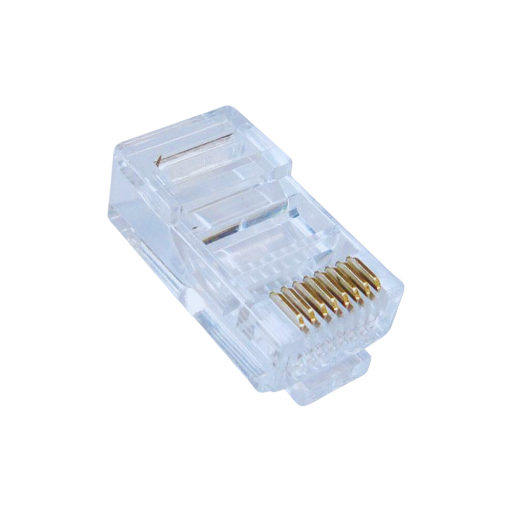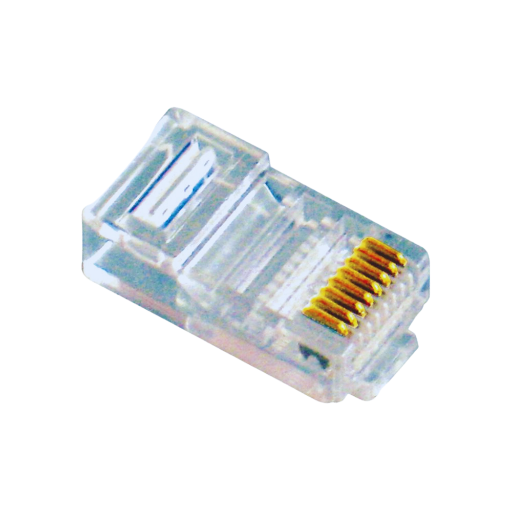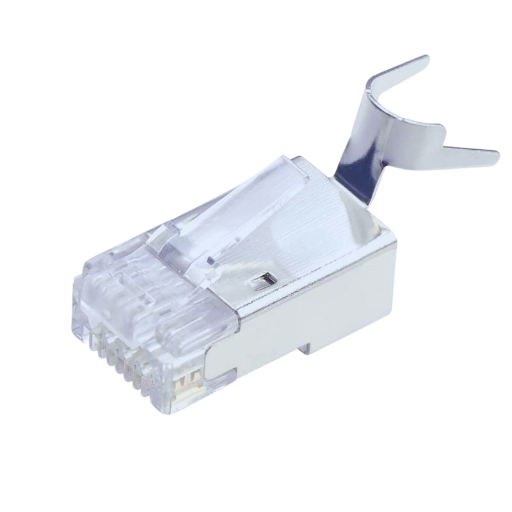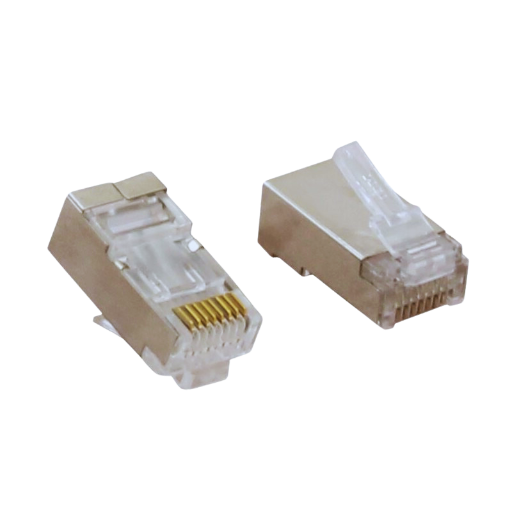RJ45 modular plugs are essential pieces of equipment in computer networking. They are used to connect devices on the same Local Area Network (LAN). This piece will elaborate on different aspects of RJ45 modular plugs, such as their design, how they work, and where they can be applied. Furthermore, we shall discuss technical details that represent these connectors, give tips on using them correctly, and provide solutions for typical problems encountered when dealing with these kinds of interconnections. Hence, after reading this article, one should have a wide knowledge of RJ45 modular plug, enabling him/her to make rational choices during network installation or any other related project.
What is an RJ45 Plug, and How is it Used?

Understanding the RJ45 Connector
An 8-pin plug is known as the RJ45 connector, and it abides by the TIA/EIA-568 cabling standard. Ethernet networks use it mainly to link with computers, routers, and switches. A simple snap-in mechanism is established within the design of this connector to ensure a secure connection. Each pin of an RJ45 corresponds to a particular wire within a certain twisted pair cable, thereby enabling data transfer at different rates, e.g., 10/100/1000 Mbps, among others. Rectangular form factor distinguishes these connectors together with their flatness as well as transparency housing that permits one to peer into them so as to verify if everything is wired rightly or not.
Applications of RJ45 Plugs in Networking
RJ45 plugs are commonly used in many different types of networks due to how flexible and dependable they can be. They act as the connector standard for Ethernet networks, allowing various devices like computers, printers, and network switches to communicate with each other seamlessly. In offices, RJ45 plugs are helpful because they provide local area network (LAN) connections, which means data can be shared over multiple devices while also having access to the internet at the same time. People also use them a lot in home setups where people may have their PC connected through this plug into a modem or router alongside entertainment systems such as TVs too! On top of that, RJ 45 connectors work well within telecommunications systems as they allow for connection points between VoIP phones among other communication equipment devices. Meanwhile, its robustness, together with compatibility across different cable types, makes this item invaluable when setting up any form of commercial or residential network infrastructure.
How to Choose the Right RJ45 Plug for Your Needs?

Differences Between Cat5e and Cat6 RJ45 Plugs
To ensure optimal performance in networking applications, it is vital to differentiate between Cat5e and Cat6 connectors when selecting RJ45 plugs. Although both categories support Ethernet technology, they have distinct performance capabilities and specifications.
Speed of Data Transfer and Frequency:
- Cat5e (Category 5e) plugs can support data transfer speeds up to 1 Gbps (Gigabit per second), with a maximum frequency of 100 MHz. These plugs are designed using advanced technology that reduces crosstalk as well as interference; thus making them suitable for most common networking needs.
- On the other hand, Cat6 (Category 6) plugs can handle data transfer rates of up to 10 Gbps, especially over shorter distances that do not exceed 55 meters. The connectors operate at a higher frequency of 250 MHz, which enables them to carry more data, thereby improving their performance in high-bandwidth applications.
Shielding and Construction:
- With fewer twisted pairs used and no additional shielding included, Cat5e plugs are lighter and cheaper compared to those with extra protection. While this construction is good enough for basic networking tasks; however they may suffer from Electromagnetic Interference (EMI) if used in areas where there are many signals around.
- For better resistance against EMI and crosstalk, Cat6 connectors come constructed with thicker wires, plus they often have improved shielding, e.g., Unshielded Twisted Pairs (UTP) or Shielded Twisted Pairs (STP). Therefore, these types work better in environments requiring higher performance due to increased shielding effectiveness.
Suitability for Application:
- Cat5e is the best choice for standard home/office network applications such as internet browsing, file sharing or video streaming among others. It works well for most medium-speed data transmission needs which do not require much bandwidth.
- On the other hand, Cat6 should be used where there’s need for fast transmission of large volumes of data i.e., in data centers or commercial setups with frequent file transfers. Its improved specifications also make it suitable for use in future-proofing networks as technology advances further.
In summary, while both Cat5e and Cat6 RJ45 plugs can be used in networking; however, the decision between them should be based on specific network environment requirements like speed of data, potential interference among others.
Shielded vs. Unshielded RJ45 Plugs
When it comes to choosing between shielded and unshielded RJ45 plugs, the main difference is how good they are at dealing with electromagnetic interference. Shielded RJ45 plugs have a layer of protection around the wires that makes them much less susceptible to EMI and crosstalk. This means that they work well in high-performance settings like data centers or places with lots of electronics. Unshielded RJ45 plugs, on the other hand, are lighter and usually cheaper; they’re designed for use in standard networking applications where there’s not much interference. The final decision on whether to go with shielded or unshielded should take into account factors such as the operational environment and equipment proximity/usage which may affect EMI susceptibility.
Factors to Consider: 8p8c, Strain Relief, and More
When choosing RJ45 plugs, it is important to consider the 8p8c configuration and strain relief features among other things. Ethernet networking uses 8p8c connectors as a standard. Compatibility with cable type and network requirements must be ensured since various configurations may affect performance and connectivity.
The term strain relief refers to an attribute that prevents stress on the cables where they meet connectors. Properly designed strain reliefs can help decrease both physical damage to wires themselves and failures in connections between them, especially under conditions involving frequent motion. For this reason, when applying plugs in networks, it is advisable to go for those with strong ones.
Apart from these considerations, one should also take into account environmental factors surrounding intended use applications; specific demands posed by different types of cables employed along with particular network setups will serve as further guidelines for making appropriate choices among available options for RJ45 plugs.
How to Properly Install an RJ45 Plug?

Tools Needed for RJ45 Plug Installation
These are the necessary tools for successful installation of RJ45 plugs:
- Cable Stripper – Used to strip off the outer insulation of an Ethernet cable while ensuring that none of its inner wires get damaged.
- Crimping Tool – Fastens an RJ45 plug onto a cable by squeezing metal pins around individual wires, thus making the connection strong enough.
- Cutting Tool – Trims a cable down to the desired length and provides neat cuts, which enhance performance greatly.
- Cable Tester – This is used after installing them so as to verify if connections were made correctly and that everything is functioning well with network cables.
With such equipment on hand, one can easily install RJ 45 plugs accurately and efficiently.
Step-by-Step Guide to Crimping an RJ45 Plug
- Prepare Ethernet Cable: Utilize a cable stripper to remove around one inch of external insulation from the end of an Ethernet cable, revealing the wires inside. Be cautious not to harm any of the inner cords.
- Untwist and Order Wires: Untwist wire pairs and arrange them according to the T568A or T568B wiring standard. Verify that they’re flat and in right order because it’s necessary for proper connectivity.
- Trim Wires: Trim wires using a cutting tool so they’re all approximately half an inch long from the sheathing.
- Insert Wires into RJ45 Plug: Gently insert aligned wires into an RJ45 plug making sure each wire goes into its slot. Push down with some pressure until you cannot see any more wire.
- Crimp RJ45 Plug Together: Put plugged cable into crimping tool, then squeeze handles tightly, which will fix metal pins inside RJ45 plug onto cables, thus establishing a connection between two devices connected by means of this physical link.
- Test Connection: Use cable tester after crimping process if connections are right and if there’s no fault created during making new ethernet cable.
Common Mistakes to Avoid During Installation
- Mistake in Wiring Arrangement: For RJ45 plug installation, the most common mistake is the use of incorrect wiring standards. You should choose between T568A and T568B and stick with it across your network for consistency reasons and to avoid any connectivity problems. Always verify that wire arrangement is correct before crimping.
- Improper Insulation Stripping: Inadequate or excessive removal of outer insulation can cause problems. When you strip off too much insulation, the wires are left exposed to interference while too little stripping prevents good contact with pins on an RJ45 plug. Ensure that you remove just enough insulation to allow for a tight fit into the plug.
- Incorrect Crimping Procedure: Weak connection or disconnection may result from not applying sufficient pressure when crimping; this is one of the common mistakes people make during crimps. On the other hand, over-crimping can damage both wires and RJ45 plugs. Therefore, always ensure even strong pressure is applied onto all sides of each wire as it gets secured by a crimp tool without causing any damage.
Where to Buy RJ45 Plugs?

Top Online Retailers for RJ45 Plugs
- Amazon: It is the place where people can find RJ45 plugs and other things that are related to it, always with an opportunity to get to read reviews by its users.
- Newegg: Deals with electronics and sells different networking components.
- Micro Center: This store specializes in computers and also sells RJ45 connectors.
- eBay: You can buy second-hand or new RJ45 plugs at the platform from different sellers.
- Cable Matters: The main products sold here relate to cabling and connectivity solutions; therefore, buyers expect to get high-quality RJ45 plugs.
- Alibaba: This website mainly focuses on bulk purchases from manufacturers; thus, it is ideal for large orders.
Product Descriptions and Customer Reviews
To ensure maximum productivity, one must take into account certain specifications and quality of RJ45 connectors. One of the most common features in high-end RJ45 plugs is gold-plated contacts, which allow for better connectivity while minimizing data loss. Go for those designed to handle standard Ethernet as well as higher-speed applications like Cat5e, Cat6, or even Cat6a. In some cases, ease of fitting stated by customers can’t be overlooked where they prefer plugs that show clear instructions and have proven durability over time through use demonstrations; also, many users express their joyfulness with such type when it comes to keeping connection tight under different environmental conditions since this makes them more reliable, especially in networking applications.
How to Maintain and Troubleshoot RJ45 Connections?

Tips for Maintaining RJ45 Plug Performance
- Regular Inspection: Periodically examine both plugs and cables to find signs of wear, rust or destruction.
- Keep Contacts Clean: Clean the gold contacts with isopropyl alcohol to maximize connection efficiency.
- Avoid Over-Tightening: Don’t force too much when connecting RJ45 plugs because this can break slots.
- Proper Storage: You should keep the cords in cool dry places so that they do not get worn out or damaged inside.
- Secure Connections: No loose connections, which would cause intermittent connectivity problems.
- Monitor Performance: Use networking tools to evaluate signal quality and troubleshoot any connection issues without delay.
How to Fix Common RJ45 Connection Issues
To fix ordinary RJ45 connection problems, one has to identify and address the root causes systematically:
- Check Physical Connections: Check all RJ45 jacks to ensure they are properly connected. Loose or disconnected plugs should be reseated tightly.
- Inspect for Damage: Look closely at cables and connectors to find any visible signs of harm, frayings, or impairment. Any damaged parts should be replaced in order to restore normal operations.
- Test with Alternative Equipment: It is important to try a different Ethernet Cable or RJ45 plug in order to investigate if the problem still exists. This can establish whether the issue lies with the original components.
- Network Configuration: The network settings of connected devices should be checked; this ensures that such configurations are correct. Incorrect IP addressing or subnet masks can lead to connectivity problems.
- Run Diagnostic Tools: Network diagnostic tools may be helpful when diagnosing signal faults or configuration errors. Cable testers like ping commands will help in isolating issues.
- Update Firmware and Drivers: For instance, outdated software can lead to performance issues; thus, it is necessary that drivers for network interface cards and firmware of networking devices (such as routers and switches) are constantly updated.
By following these steps sequentially, diagnosing and resolving common RJ45 connection issues can be done effectively.
Reference Sources
Modular connector
Category 6 cable
Electrical connector
Frequently Asked Questions (FAQs)
Q: What is an RJ45 Modular Plug?
A: An RJ45 Modular Plug is a connector commonly used for network cabling, such as Ethernet connections. It interfaces with RJ45 jacks to create a secure and reliable connection between devices.
Q: What are the differences between Cat5e RJ45 and Cat6 RJ45 Modular Plugs?
A: Cat5e cables use Cat5e plugs, which support maximum speeds of 1 Gbps, while Cat6 cables depend on the type of plug used so as to have capacities of up to 10 Gbps. Additionally, cat6 connectors have increased performance criteria and better methods of protection.
Q: What is the significance of the 8P8C designation for RJ45 Modular Plugs?
A: This plug has eight receptacles or positions for wires and eight electrical contacts; hence, it is referred to as “8 positions and 8 contacts” (8P8C). This serves as a compatibility standard for all types of RJ-45 connectors that interface with switches.
Q: Can RJ45 Modular Plugs be used with both solid and stranded wire cables?
A: Yes, this type of plug can work with both solid or stranded wire cables. Nevertheless, it would be crucial to ensure that the right type of modular plug be used for each cable in order to establish reliability in connection making. This suggests that one should consider buying special plugs specifically meant for solid conductors or just stranded ones.
Q: How critical is gold plating on RJ45 Modular Plugs?
A: Gold plating plays a vital role in sustaining connectivity over time. The advantage of micro-inch gold plating on contact surfaces vis-à-vis resistance to corrosion can hardly be overstated since it guarantees continual electrical contact throughout extended periods.
Q: What is the purpose of a strain relief boot in RJ45 Modular Plugs?
A: It provides added durability and helps maintain signal integrity, prolonging the life of the connector. This aids in protecting both the cable and the plug from mechanical stress and bending.
Q: Are there specific RJ45 Modular Plugs for Cat6 Shielded Cables?
A: For high-performance data transmission, Cat6 Shielded RJ45 Modular Plugs are designed for use with shielded cables in order to reduce electromagnetic interference (EMI) and crosstalk.
Q: What tools are needed for field termination of RJ45 Modular Plugs?
A: In most cases, you will need a crimping tool dedicated to RJ45 plugs, a wire stripper used to prepare the cable, and a tester that verifies your connection. Some advanced plugs may also require additional tools such as a punch-down tool.
Q: How many plugs are typically included in a 100-Pack of RJ45 Modular Plugs?
A: These packs make it easy to do large projects or keep connectors around for future needs so that you can just get one pack, which includes 100 individual ones, enough to terminate 100 cables. A hundred-pack of RJ45 modular plugs comes with one hundred separable plugs, allowing you to terminate 100 cables.
Post Views: 1,973




